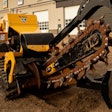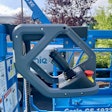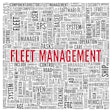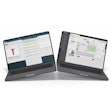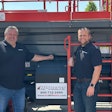
The entire construction industry has been tasked to continue to do business with less. Professional contractors are struggling with a challenged labor market, homeowners face high interest rates, and wages aren’t keeping up with the price of goods. All of these factors plus many more are pushing everyone to do more with less.
Yet, there’s optimism. For independent general equipment and tool rental stores, markets like these tend to present an opportunity for rentals as homeowners and pros alike may not find it justifiable to purchase equipment for occasional use. The expectations and projections report growth.
According to John Jeanguenat, Vice President for the Equipment Segment at the American Rental Association (ARA), the most popular requests from rental stores are industry-specific training/education, workforce development, government advocacy and theft prevention. He says that the ARA have addressed these by developing several industry-specific certifications in recent years. They’ve also helped rental companies hire by developing tools to recruit qualified employees. The ARA Job Portal connects members job postings with jobseekers through partner sites like CareerBuilder, Monster, Circa and Hire Veterans.
Reports from the ARA tell a story of continued growth for the equipment rental industry in 2025—albeit at a moderated pace compared to previous years. Tim Morris, the chief commercial officer at JLG, attributes this to several factors: fluctuations in economic conditions causing potential slowdowns in certain construction segments, which may influence demand for certain types of rental equipment, and inflationary pressures from rising costs impacting profit margins, underscoring the challenges posed by inflation.
“While the equipment rental industry will likely experience moderate growth in 2025,” says Morris, “strategic adaptations that focus on technological innovation (integrating digital solutions and sustainable practices to drive operational efficiency and open new market opportunities) and sustained infrastructure investments (ongoing government initiatives are expected to bolster demand for rental equipment) are expected to support its continued expansion.”
Likewise, Jeanguenat says the supply chain is starting to balance out. The industry has swung from an excess demand to excess supply. Manufacturer production seems to have returned to normal after the flattening of demand in 2023/2024—leaving the industry swinging back to supply. “In 2025, I would expect the supply chain to get back closer to a normal supply-demand balance,” he says.
Matt Nelson, director of municipal business at Diamond Mowers, is seeing a more stable supply chain: “The supply chain is generally normalized now, with lead times and availability similar to pre-COVID times.”
Jeff Young, senior director of strategic accounts at the Bobcat Company shares in Nelson’s optimism for the year: “We anticipate little industry contraction in 2025 and expect trends to remain steady.”
“While the equipment rental industry will likely experience moderate growth in 2025, strategic adaptations that focus on technological innovation and sustained infrastructure investments are expected to support its continued expansion.”
—Tim Morris, Chief Commercial Officer, JLG
The growth outlook for the U.S. GDP in 2025 ranges from 1.9 to 2.5 percent. According to “Voice of Customer Surveys” conducted in Q4 of 2024, Noregon found that 37 percent of shops and 27 percent of fleets reported a positive outlook for the trucking industry while 62 percent of shops and 56 percent of fleets reported a positive outlook for their shops (independent repair facilities, dealerships, and fleets’ in-house repair shops). Sandeep Kar, chief strategy officer at Noregon Systems LLC explains that these numbers may be because a weak outlook for the trucking industry means fleets will delay equipment purchase decisions which will result in more frequent service and maintenance demands emanating from existing equipment.
“This also implies that fleets will continue relying on rental equipment to operate with a CAPEX-Light business model,” he says.
Several sectors within the construction industry are projected to experience notable growth in the coming year.
- Residential Construction: After a period of decline, the residential sector is anticipated to rebound. This resurgence is attributed to sustained demand for suburban and rural housing.
- Nonresidential Construction: The nonresidential segment is expected to grow, particularly through significant investments projected in healthcare and educational facilities. These investments are being driven by the need to modernize infrastructure for expanding and aging populations. Additionally, the rise of data centers and technology hubs is fueling demand for advanced digital infrastructure.
- Infrastructure Development: Government initiatives, such as the Infrastructure Investment and Jobs Act (IIJA) and the Inflation Reduction Act (IRA), will contribute to growth in this sector.
- Technological Integration: The adoption of advanced technologies, including augmented reality, drones, modular construction and artificial intelligence, is transforming construction practices. These innovations aim to improve efficiency, address labor shortages and reduce costs.
- Sustainability and Prefabrication: There’s an increasing emphasis on sustainable building practices and prefabricated components.
Morris expects that with increased construction activity, the demand for rental equipment should rise largely because long-term rental contracts provide a cost-effective alternative for construction firms looking to avoid high capital investment costs. “By expanding rental equipment offerings to include modern, high-demand equipment, including electric machines, independent rental companies can position themselves to take full advantage of the construction boom and drive long-term profitability,” he says. @martinfredy - stock.adobe.com
@martinfredy - stock.adobe.com
However, although non-residential spending was up in 2024 in the private sector, reports from the Associated Builders & Contractors forecast that some segments within this market are projected to slow down or stabilize in 2025: the construction of large, privately-owned spaces such as data center and warehouse construction due to space saturation and a temporary slowdown in e-commerce growth. The growth in manufacturing construction is expected to stabilize with major projects being completed coupled with economic uncertainties inspiring a more cautious approach to new investments.
Morris explains: “Various economic and market factors contributing to the decline in these segments include:
- Tighter Credit Conditions: Increased interest rates and stricter lending standards have made financing new projects more challenging, leading to delays or cancellations;
- Rising Construction Costs: Inflation and tariffs on materials has escalated overall expenses, causing some developers to postpone or scale back projects;
- Declining Commercial Property Values: Weak demand in certain markets has decreased property values, reducing the incentive for new commercial developments; and
- Supply Chain Disruptions: Ongoing supply chain issues have delayed obtaining essential materials and equipment, further hindering project timelines and increasing costs.
The effect of high interest rates on the rental industry included a situation where it was more expensive to acquire assets and tighter budgets caused more caution in spending which slowed construction projects which—in turn— reduced rental demand in some sectors. Inflation and high financing costs also limited rental company’s profit margins causing some to absorb the cost or raise prices to customers.
However, Morris says there’s a positive side. Higher interest rates have reinforced the demand for rental equipment instead of purchasing new; companies with well-maintained fleets were able to capitalize.
“Looking forward, rental demand is expected to remain strong in 2025,” says Morris. “As long as borrowing costs remain elevated, more construction firms will choose to rent rather than buy, benefiting rental companies. This could limit equipment availability, leading to potential rental rate increases. Also, government-backed infrastructure projects, which are less affected by interest rate hikes, will continue driving demand for rental equipment. Companies that align with public works projects will be more insulated from economic downturns.”
The ARA’s Rentalytics forecasting data also sees continued but slowing growth for the equipment rental industry. They forecast between 5 to 6 percent in the U.S. and slightly more for Canada (7 to 8 percent).
Jeanguenat explains that this growth comes from. “Interest rate increases in 2023 and 2024 increased financing costs for equipment purchases and reduced consumer demand because there was a slowdown in construction and development (especially in residential construction). Interest rates have slowly decreased over the last 6 months, and there is uncertainty about where interest rates will go in 2025. There is optimism that lower interest rates to start 2025 will spur construction and development and, in turn, demand for rental equipment,” he says.
Watch interest rate and inflation trends for any chance of balancing out. If inflation returns to historically-normal levels and interest rates decline, Jeanguenat says he expects to see an increase in new equipment purchases in 2025 and beyond.








